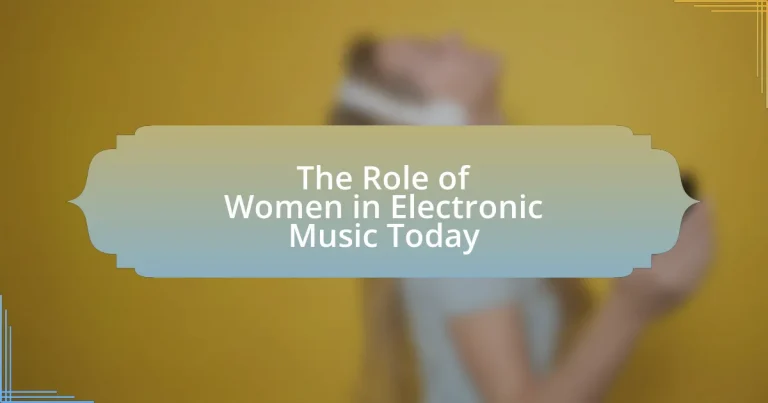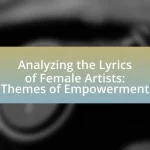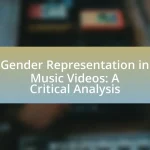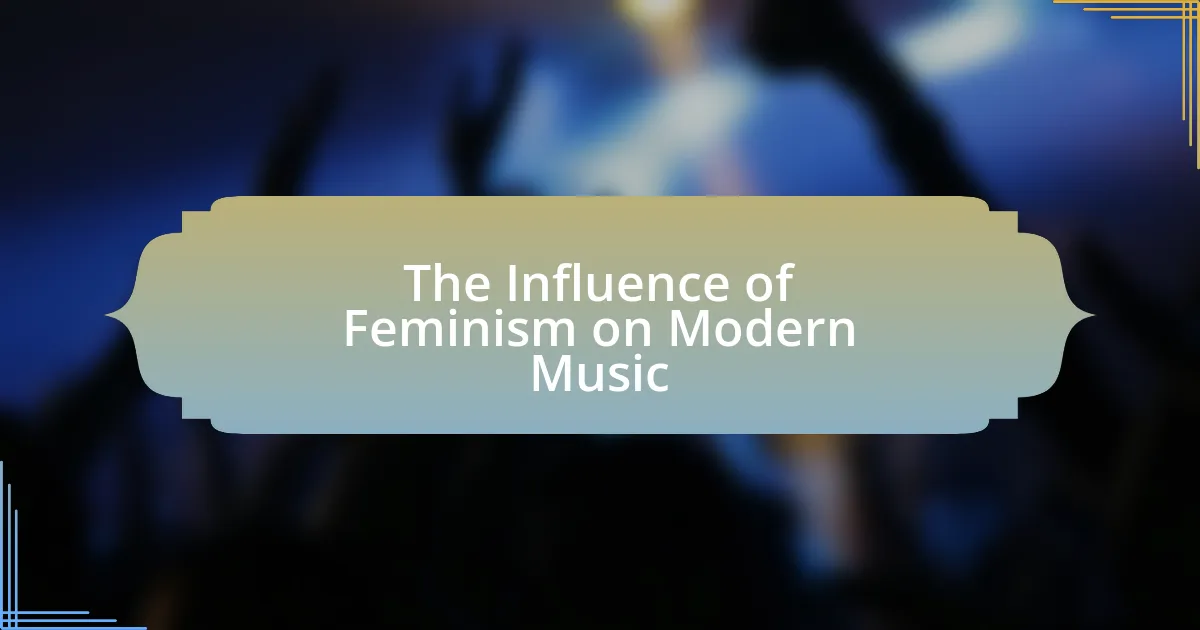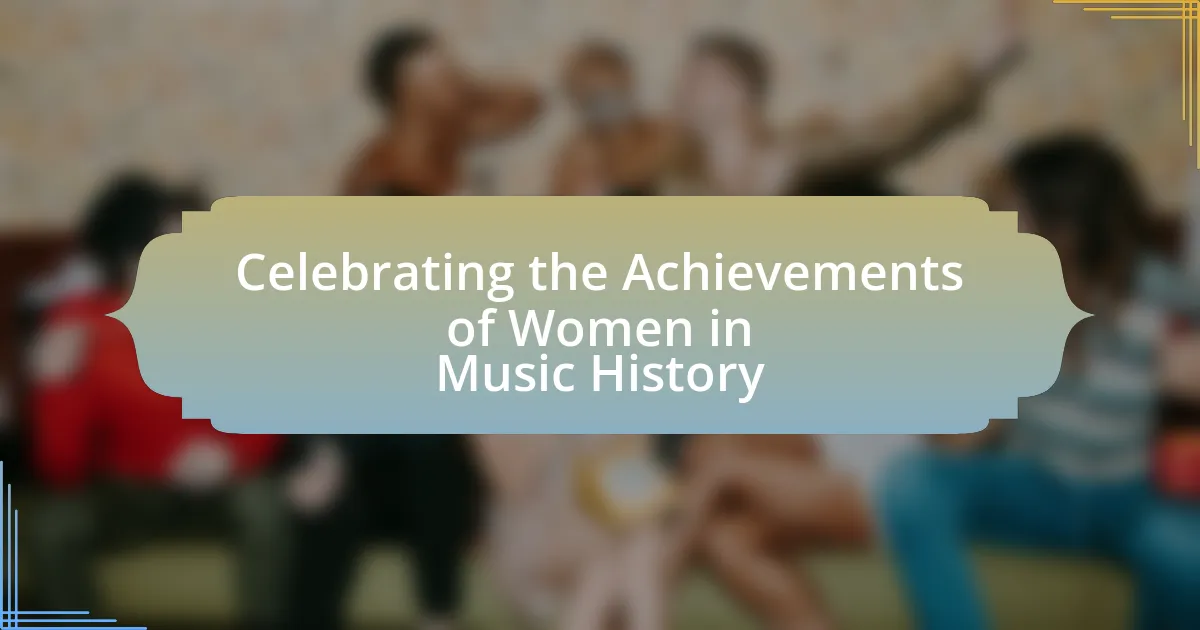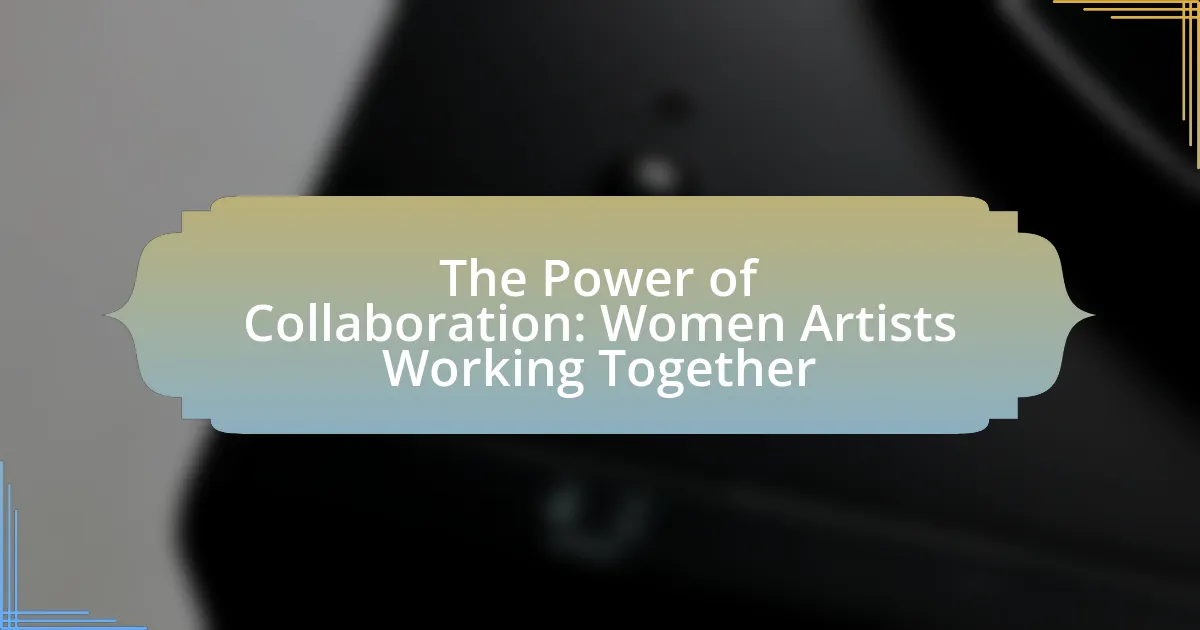The article examines the significant role of women in electronic music today, highlighting their contributions as artists, producers, and DJs. It discusses the evolution of women’s representation in the genre, noting historical milestones and the impact of societal changes on their participation. The article also addresses the challenges women face, including gender discrimination and underrepresentation, while emphasizing the importance of initiatives and organizations that support female talent. Furthermore, it explores how women influence the sound and culture of electronic music, shaping its future through increased visibility and innovative contributions.
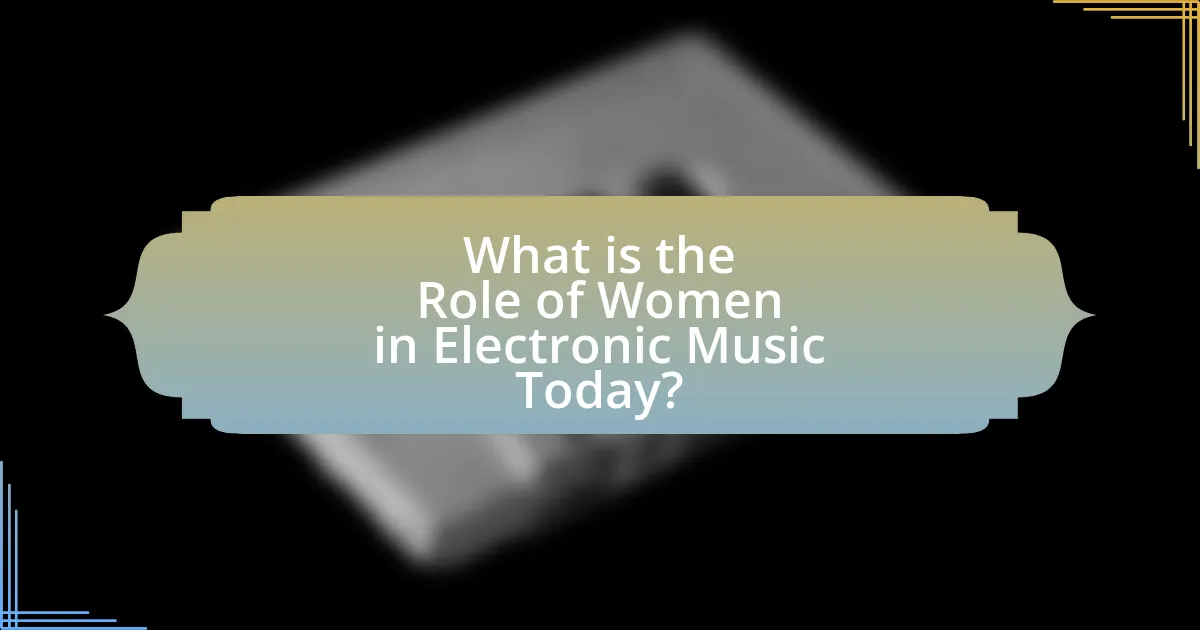
What is the Role of Women in Electronic Music Today?
Women play a crucial role in electronic music today, significantly influencing the genre as artists, producers, and DJs. Their contributions have led to a more diverse and innovative soundscape, with many women gaining recognition in mainstream and underground scenes. For instance, artists like Charlotte de Witte and Nina Kraviz have achieved international acclaim, showcasing their talents on global stages and headlining major festivals. Additionally, initiatives such as She Is The Music and the Women’s Audio Mission aim to support and promote female talent in the industry, addressing historical gender imbalances. Statistics indicate that the presence of women in electronic music has been steadily increasing, with more female artists being featured in lineups and receiving media coverage, thereby reshaping the narrative around gender in this field.
How has the representation of women in electronic music evolved over the years?
The representation of women in electronic music has significantly evolved from being largely marginalized to gaining increased visibility and recognition. Historically, women faced barriers in a male-dominated industry, with only a small percentage of female artists being acknowledged in mainstream electronic music. For instance, a 2018 study by the USC Annenberg Inclusion Initiative found that only 22.5% of artists in the electronic genre were women.
In recent years, initiatives aimed at promoting gender equality, such as the establishment of female-focused festivals and mentorship programs, have contributed to a rise in female representation. Notable artists like Charlotte de Witte and Nina Kraviz have gained international acclaim, showcasing the growing acceptance and celebration of women in this field. Additionally, organizations like Keychange have advocated for gender parity in music festivals, further highlighting the shift towards inclusivity.
This evolution reflects broader societal changes regarding gender roles and the increasing recognition of women’s contributions to electronic music, marking a significant transformation in the landscape of the genre.
What historical milestones have marked women’s contributions to electronic music?
Women’s contributions to electronic music have been marked by several historical milestones, including the pioneering work of composers like Delia Derbyshire, who created the first electronic music for television with the Doctor Who theme in 1963. Additionally, Wendy Carlos’s album “Switched-On Bach,” released in 1968, popularized the Moog synthesizer and showcased women’s capabilities in electronic music production. In the 1980s, artists like Laurie Anderson and Suzanne Ciani further expanded the genre, with Ciani being recognized for her innovative use of synthesizers and sound design. The establishment of organizations such as the Women’s Audio Mission in 2003 has also played a crucial role in promoting women’s involvement in the field, providing training and resources to aspiring female audio engineers and producers. These milestones collectively highlight the significant impact women have had on the evolution and acceptance of electronic music.
How have societal changes influenced women’s participation in this genre?
Societal changes have significantly increased women’s participation in electronic music by promoting gender equality and challenging traditional gender roles. The rise of feminist movements and advocacy for women’s rights in the late 20th and early 21st centuries has led to greater visibility and support for female artists in the music industry. For instance, initiatives like the “Women in Music” organization and festivals that prioritize female lineups have created platforms for women to showcase their talents. Additionally, the advent of technology and social media has empowered women to produce and distribute their music independently, further enhancing their presence in the genre. Statistics indicate that the percentage of women in electronic music has risen, with reports showing that female artists now comprise approximately 30% of festival lineups, compared to just 10% a decade ago.
What challenges do women face in the electronic music industry?
Women in the electronic music industry face significant challenges, including gender discrimination, underrepresentation, and a lack of access to opportunities. Research indicates that women make up only about 10-15% of artists in electronic music festivals, highlighting their underrepresentation. Additionally, women often encounter biases that can limit their visibility and career advancement, as evidenced by studies showing that female DJs and producers receive less media coverage and fewer booking opportunities compared to their male counterparts. Furthermore, the industry culture can be unwelcoming, with reports of harassment and sexism creating barriers for women trying to establish themselves in this field.
What barriers exist for women in terms of access and opportunities?
Barriers for women in electronic music include gender bias, lack of representation, and limited access to resources. Gender bias manifests in the form of stereotypes that question women’s technical abilities and creativity, often leading to fewer opportunities for women to perform or be recognized in the industry. The lack of representation is evident in the disproportionate number of male artists and producers, which can discourage women from pursuing careers in electronic music. Additionally, limited access to resources such as funding, mentorship, and networking opportunities further hinders women’s ability to succeed in this field. According to a 2020 report by the PRS Foundation, only 16% of music producers are women, highlighting the significant gender gap in access and opportunities within the industry.
How do gender biases manifest in the electronic music scene?
Gender biases in the electronic music scene manifest through underrepresentation of women in key roles, unequal opportunities, and pervasive stereotypes. Research indicates that women make up only about 10-20% of artists in electronic music festivals, highlighting their marginalization in a predominantly male-dominated industry. Additionally, women often face challenges such as being overlooked for bookings, receiving less media coverage, and encountering gender-based discrimination, which reinforces the stereotype that electronic music is primarily a male domain. Studies, including those by the Association for Electronic Music, reveal that these biases not only limit women’s visibility but also impact their career advancement and recognition within the scene.
What impact do women have on the sound and culture of electronic music?
Women significantly influence the sound and culture of electronic music by introducing diverse perspectives and innovative techniques. Their contributions range from pioneering new genres, such as techno and house, to shaping the aesthetics and narratives within the electronic music scene. For instance, influential artists like Delia Derbyshire, who was part of the BBC Radiophonic Workshop, played a crucial role in the development of electronic soundscapes in the 1960s. Additionally, contemporary figures like Nina Kraviz and Charlotte de Witte have not only achieved commercial success but also challenge gender norms within the industry, promoting inclusivity and representation. Studies indicate that female producers and DJs often bring unique emotional and thematic elements to their work, enriching the overall landscape of electronic music.
How do female artists influence the genre’s evolution and trends?
Female artists significantly influence the evolution and trends of electronic music by introducing diverse perspectives and innovative sounds. Their contributions often challenge traditional norms, leading to the emergence of new subgenres and styles. For instance, artists like Grimes and Björk have pushed boundaries by blending electronic music with pop and experimental elements, thereby expanding the genre’s appeal and complexity. Additionally, studies show that female producers and DJs are increasingly shaping festival lineups and playlists, which directly impacts audience preferences and industry standards. This shift not only enhances representation but also fosters a more inclusive environment that encourages creativity and collaboration across genders.
What unique perspectives do women bring to electronic music production?
Women bring diverse perspectives to electronic music production, often emphasizing emotional depth, inclusivity, and innovative collaboration. Their unique experiences shape the soundscapes they create, leading to a broader range of themes and narratives in their music. Research indicates that female producers frequently challenge traditional norms, introducing fresh ideas and techniques that enhance the genre’s evolution. For instance, a study by the USC Annenberg Inclusion Initiative found that women in music often prioritize community-building and mentorship, fostering a more supportive environment in an industry historically dominated by men. This approach not only enriches the creative process but also encourages greater representation and diversity within electronic music.
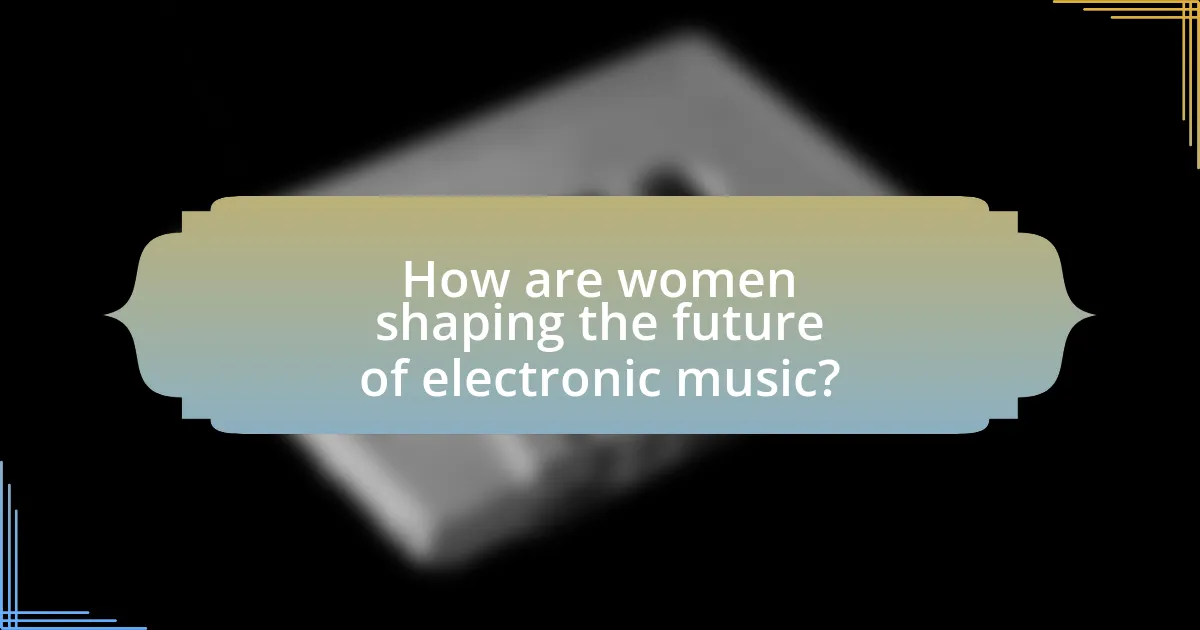
How are women shaping the future of electronic music?
Women are shaping the future of electronic music by increasing their representation in production, performance, and innovation within the genre. Female artists like Charlotte de Witte and Nina Kraviz are not only headlining major festivals but also influencing the sound and direction of electronic music through their unique styles and approaches. According to a 2021 report by the Association for Electronic Music, women accounted for 30% of artists in electronic music, a significant increase from previous years, indicating a growing presence and impact. Additionally, initiatives such as SheSaidSo and the Femme House project are actively promoting female talent and providing resources for women in the industry, further solidifying their role in shaping the future landscape of electronic music.
What initiatives support women in electronic music today?
Initiatives that support women in electronic music today include organizations like SheSaidSo, which promotes female artists and industry professionals through networking and mentorship programs. Additionally, the initiative Girls Make Beats provides educational opportunities for young women to learn music production and DJing, empowering them to enter the electronic music scene. Research indicates that these initiatives have led to increased visibility and representation of women in the industry, addressing the gender imbalance that has historically existed in electronic music.
Which organizations are dedicated to promoting female artists in this field?
Organizations dedicated to promoting female artists in electronic music include the Association for Women in Music, which supports women in all areas of the music industry, and She Said So, a global network that empowers women in the music business. Additionally, the Female:Pressure network focuses specifically on promoting female artists in electronic music, providing visibility and support through various initiatives. These organizations contribute to increasing representation and opportunities for women in the electronic music scene.
How do mentorship programs contribute to women’s success in electronic music?
Mentorship programs significantly enhance women’s success in electronic music by providing guidance, networking opportunities, and skill development. These programs connect aspiring female artists with experienced professionals who can offer insights into the industry, helping to navigate challenges and build confidence. Research indicates that women who participate in mentorship initiatives report increased visibility and access to resources, which are crucial for career advancement. For instance, a study by the Women’s Audio Mission found that 90% of women involved in their mentorship programs felt more empowered to pursue their music careers, highlighting the direct impact of mentorship on their success in the electronic music scene.
What role do festivals and events play in highlighting female talent?
Festivals and events play a crucial role in highlighting female talent by providing platforms for women artists to showcase their work and gain visibility in the electronic music scene. These gatherings often feature lineups that prioritize gender diversity, which helps to challenge the historical underrepresentation of women in the industry. For instance, events like the Amsterdam Dance Event and the Women in Music Festival have made concerted efforts to include more female performers, thereby increasing their exposure and opportunities for networking. Research indicates that festivals with diverse lineups not only attract larger audiences but also contribute to a more inclusive culture within the music community, ultimately empowering female artists and inspiring future generations.
How do female-focused events change the landscape of electronic music?
Female-focused events significantly alter the landscape of electronic music by promoting inclusivity and visibility for women artists. These events create platforms where female DJs, producers, and musicians can showcase their talents, thereby challenging the male-dominated narrative of the genre. For instance, initiatives like the “She Can DJ” competition have highlighted the skills of female DJs, leading to increased representation in lineups at major festivals. Research indicates that events emphasizing female participation can lead to a 30% increase in female attendees at electronic music festivals, fostering a more diverse audience and encouraging a shift in industry norms.
What are some notable festivals that prioritize women in their lineups?
Notable festivals that prioritize women in their lineups include the all-female lineup festival “Sisterhood Festival,” which showcases female artists across various genres, and “Girls Get Busy,” a festival dedicated to promoting women in music. Additionally, “Shambhala Music Festival” has made significant efforts to feature female artists prominently in their lineup, reflecting a commitment to gender diversity. These festivals not only highlight female talent but also aim to create a more inclusive environment in the music industry.
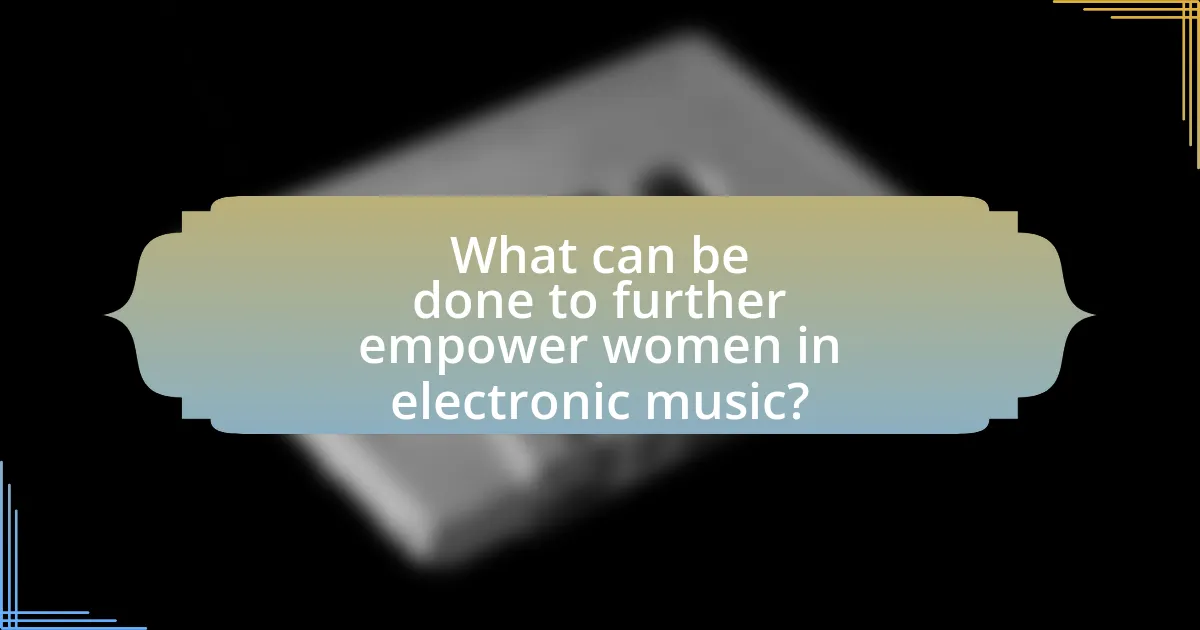
What can be done to further empower women in electronic music?
To further empower women in electronic music, initiatives must focus on increasing visibility and access to resources. Establishing mentorship programs that connect aspiring female artists with established professionals can provide guidance and support. Additionally, creating platforms that showcase female talent, such as festivals and online streaming events, can enhance their presence in the industry. Research indicates that women are underrepresented in electronic music, with only 17% of festival lineups featuring female artists, highlighting the need for targeted efforts to promote gender diversity. By implementing these strategies, the electronic music scene can foster a more inclusive environment for women.
How can industry stakeholders support female artists more effectively?
Industry stakeholders can support female artists more effectively by implementing equitable hiring practices and providing mentorship opportunities. Research indicates that women are underrepresented in the electronic music industry, with only 16% of festival lineups featuring female artists in 2019, according to a study by the PRS Foundation. By actively promoting female talent through diverse programming and ensuring equal pay, stakeholders can create a more inclusive environment. Additionally, establishing mentorship programs that connect emerging female artists with established professionals can foster growth and visibility, further enhancing their presence in the industry.
What strategies can labels implement to promote gender equality?
Labels can implement strategies such as establishing equitable hiring practices, creating mentorship programs, and promoting female artists through targeted marketing campaigns to promote gender equality. Equitable hiring practices ensure that women are represented in all roles, from production to management, which is crucial given that women make up only about 20% of the electronic music industry. Mentorship programs can support emerging female talent by connecting them with experienced professionals, fostering a supportive network that encourages career growth. Additionally, targeted marketing campaigns that highlight female artists can increase their visibility and marketability, addressing the historical underrepresentation of women in electronic music.
How can audiences contribute to a more inclusive electronic music scene?
Audiences can contribute to a more inclusive electronic music scene by actively supporting diverse artists and promoting equitable representation at events. When audiences choose to attend performances by women and underrepresented groups, they help to create a demand for diversity in lineups, which can influence promoters and venues to prioritize inclusivity. Research indicates that events featuring diverse lineups attract larger audiences, demonstrating that inclusivity is not only socially responsible but also commercially viable. By advocating for and participating in initiatives that highlight the contributions of women in electronic music, audiences can foster an environment where all artists have the opportunity to thrive.
What are some best practices for aspiring female electronic musicians?
Aspiring female electronic musicians should focus on building a strong network and honing their technical skills. Networking is crucial as it opens doors to collaborations, mentorships, and opportunities within the industry. Engaging with online communities, attending workshops, and participating in music festivals can enhance visibility and connections.
Additionally, mastering production software and understanding sound design are essential for creating high-quality music. Research indicates that women in music technology often face barriers, so developing technical proficiency can empower female musicians to assert their presence in a male-dominated field. According to a 2020 report by the Annenberg Inclusion Initiative, only 2.6% of producers in popular music are women, highlighting the importance of skill development for aspiring female artists.
Lastly, embracing authenticity and personal style can help female musicians stand out in a competitive landscape. By expressing unique perspectives and experiences through their music, they can resonate with diverse audiences and contribute to the evolving narrative of women in electronic music.
What skills should women focus on developing in the electronic music industry?
Women in the electronic music industry should focus on developing technical skills, networking abilities, and creative production techniques. Technical skills include proficiency in digital audio workstations (DAWs) like Ableton Live or Logic Pro, which are essential for music production. Networking abilities are crucial for building relationships within the industry, as studies show that collaboration often leads to greater opportunities and visibility. Creative production techniques, such as sound design and arrangement, are vital for creating unique music that stands out in a competitive market. According to a 2021 report by the International Music Summit, women represent only 20% of the electronic music scene, highlighting the need for increased skill development to enhance representation and influence.
How can networking enhance opportunities for women in this field?
Networking enhances opportunities for women in electronic music by facilitating connections that lead to collaborations, mentorships, and visibility in the industry. These connections can provide access to resources, knowledge sharing, and support systems that are crucial for career advancement. For instance, a study by the Women’s Audio Mission found that women who networked within the industry reported increased job opportunities and higher confidence levels in their skills. Additionally, networking events often showcase female talent, helping to break down barriers and promote diversity in a traditionally male-dominated field.
